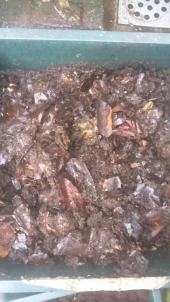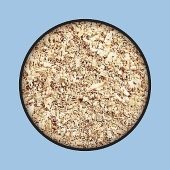posted 6 years ago
Commercial vermicompost producers typically pre-compost their feedstocks, and then dry and screen their end product to make it uniform and shelf-stable. There are often a lot of aging steps involved as well - the feedstocks (such as manure) may be aged before being fed to the worms, and the vermicompost may be aged before sale as well. I don't see anything to criticize in this, but home vermicomposting has a different process with different aims, so naturally a different result.
My biggest challenges with home-produced vermicompost are that the end product is initially very wet and sticky, like heavy lumps of clay, and that the finished vermicompost has a lot of worms and worm cocoons in it, despite efforts to separate the worms via various methods. Drying and hand-screening help a lot with the first problem. When the worm bin is indoors, the drying step can be more challenging - I find it goes a lot faster in warm breezy weather outside, whereas indoors I'd have to plug in fans and so forth to get more air circulation, and I dislike the extra hassle and electricity use. Hand-screening is labor intensive, and aging the vermicompost until all of the worm eggs have hatched and the worms can be baited out into material with fresh food, is also burdensome. So I only process a portion of my vermicompost this way - and use that portion exclusively for my container plants.* The wetter, lumpier stuff that still has worms and cocoons in it can go straight into my garden, although big lumps generally shouldn't be allowed to sit on the soil surface and dry out because they become hard as rock.
(*Live red wigglers in container plants cause problems. In my experience, they can live in a plant pot a remarkably long time, and their continual reprocessing of the planting mix means the roots of the plant cannot grow. Either the worms are eating the fine roots outright, or their constant digging is constantly killing those roots - either way, the result is the same. When I finally realize what's happening and tip the pot out, I get a stunted plant with a tiny root mass out of the top of the pot, and the rest of the potting mix is soggy and gooey and falls apart because it's been re-eaten by worms continually. This has happened to me with small houseplants as well as sizeable container plants outside.)
Another approach to over-wet vermicompost is to use a more breathable bin system - either wood, or one of the newer breathable fabric flow-through bins. I have a commercially made, stacking tray system currently and am constantly frustrated with the amount of moisture it retains. I never spray water in the bin or soak the bedding - all the water comes from the kitchen scraps that are my main feedstock, and it naturally seeps downward through the trays and keeps the oldest trays quite wet. I am contemplating getting a more breathable system. I have also come to the conclusion that too much moisture in the lower trays contributes a lot to the problem of worm cocoons in the finished product, because the worms like to lay their eggs in those soggy lower layers when they're available.
I know I'm responding to a thread that is several years old, but all this is fresh in my mind because I just read the excellent "Worm Farmer's Handbook" by Rhonda Sherman of NC State, which gives a lot of info about how large-scale commercial and institutional worm farms operate. Most of it is not directly applicable to my own very small-scale, personal vermicomposting, but I take an interest anyway.

 1
1




 3
3












 3
3








 2
2




















 1
1




 Have been vermicomposting at home (2-plastic bucket system, kitchen scraps) for a few years and have always been frustrated with the dense wet clay-like consistency. Without more processing the big clumps turn hard as rocks as someone else mentioned, and is not as easily incorporated into our small kitchen garden.
Have been vermicomposting at home (2-plastic bucket system, kitchen scraps) for a few years and have always been frustrated with the dense wet clay-like consistency. Without more processing the big clumps turn hard as rocks as someone else mentioned, and is not as easily incorporated into our small kitchen garden.
 Thanks all.
Thanks all.









